The majority of Metro Manila was at a standstill when tropical storm Fung-Wong, known locally as Typhoon Mario, triggered heavy rains on September 19, 2014. Online users questioned whether the weather disturbance was actually the second coming of Ondoy, which wreaked havoc on the capital in the same month back in 2009.
Government agencies like the Metro Manila Development Authority (MMDA), Department of Science and Technology, and the National Disaster Risk Reduction & Management Council (NDRMMC) were working around the clock to ensure public safety as the harsh effects of the typhoon were further aggravated by the summer monsoon (Habagat).
Perhaps the common, most important question that has surely escaped every person’s lips that day was this: Is there flooding in your area?
In this article, we take a look at some of the areas in Metro Manila that are surprisingly flood free based on the Geohazard Map of the Philippines, which is made by the Department of Environment and Natural Resources – Mines and GoeSciences Bureau.
Taguig

Did you know that Taguig is known as a fishing community? Despite its location, which is near Laguna de Bay, as based on this map by the Mines and GeoSciences Bureau of the Department of Environment and Natural Resources, only a few areas in the city are affected by flooding. The city government’s pumping station and floodgate has been credited by locals as the reason why the effects of flooding in recent years have been minimal. Moreover, the city government’s disaster preparedness program was highly commended by the Department of Internal and Local Government last year thanks to its effective contingency plans.
Taguig is also famous for its highly urbanized district called Bonifacio Global City. The mixed-use development, which had been built from the ground up on a former mountainous expanse, is located at the highest part of the city. McKinley Hill is also home to some of the latest luxurious properties in Manila. It has also been reported that Ayala Land has started developing the Food Terminal in southern Taguig to turn it into another BGC-like area.
Makati
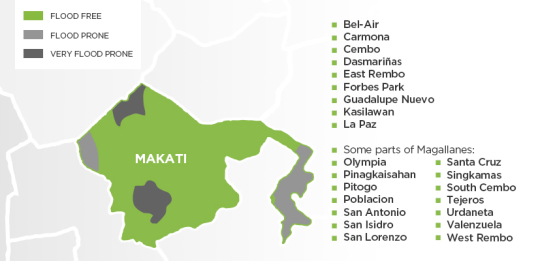
Contrary to public opinion, Makati has certainly risen to the challenge of playing host to the number of people who come in for work every day in the already heavily populated city. Based on 2010 National Census population numbers, Makati is ranked the 16th most densely populated city in the world, in addition to containing the majority of the country’s businesses. Aside from commuter traffic, the city government also needs to ensure that it remains flood-free despite the fact that it is right smack in the middle of two large bodies of water: Manila Bay and Laguna de Bay. Makati is also near Pasig River, which connects both bays.
Although the financial district along major roads Ayala Avenue, Gil Puyat Avenue, and Kalayaan Avenues should be spared from the effects of flooding as based on the geohazard map, it’s been reported that Mayor Jejomar Erwin Binay has since ordered daily dredging operations of the Makati diversion channel to avoid future flash floods and traffic jams.
Mandaluyong
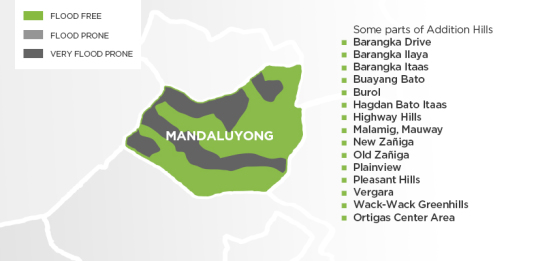
Just like Makati, Mandaluyong is also surrounded with the three bodies of water, with the addition of San Juan River. In an online news report of ABS-CBN, the southern part of Mandaluyong is mostly prone to flash floods.
On the other hand, commuters would observe that Mandaluyong is a city full of peaks and valleys. Before the urban development, the city was once a rolling topography full of hills.
As such, property developers has favored the higher levels of the city for their projects. Ortigas Center, which is the second most important business district after Makati, is relatively passable during bad weather. Apart from the fact that its location is accessible for some of the country’s biggest brands, Ortigas houses all the basic amenities a family would need at a moment’s notice. Megamall, Robinsons and The Podium are just some of the few malls located in Ortigas.
Muntinlupa/Las Piñas
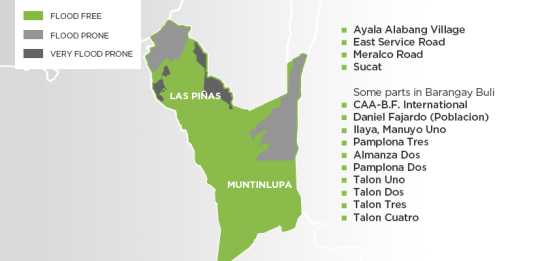
If there’s any indication as to why Muntinlupa is included on this list, it is the fact that it is home to one of the most exclusive communities in the country: Ayala Alabang. Alabang is home to Alabang Town Center, Ayala Alabang Village, El Molito Complex, and Madrigal Business Park. Moreover, the city has been dedicated to ensuring that its waterways remain open by being the first in the metro to issue a citywide ban on the use of styrofoam and plastic products. Garbage from said products has long been credited as the main item found in blocked drainage systems.
Las Piñas, on the other hand, is barely mentioned even in the news whenever a storm is expected to hit Manila. Despite the fact that the city’s location is threatened with the possibility of flooding due to its proximity to both Manila and Laguna Bays, the city is known as one of the cleanest cities in the metro. Las Piñas is home to some of the largest developments in the country, including SM Southmall.
Quezon City

Yes, this is no typo. Despite the fact that Quezon City has made the rounds in the news every time flooding is reported, most major parts of the city are relatively passable during storms. The city houses the nation’s major government offices, including Batasang Pambansa Complex, and two premier schools in the country, the Diliman campus of the University of the Philippines and the Jesuit-run Ateneo de Manila University.
Megaworld Corporation’s 17-acre mixed development called Eastwood City is also located in Quezon City, and houses the headquarters of some of the biggest BPO companies in the country like Accenture and Dell. The city is also the location of a string of business parks, including the UP Science And Technology Park (North).
The city government under Mayor Herbert Bautista reasoned that there are certain residential establishments and a few facilities that were built in low-lying areas or near bodies of water. For example, the University of the East Ramon Magsaysay Memorial Medical Center and United Doctors Medical Hospital are both located near a branch of the Pasig River.
The LGU has also since declared that Bagong Silangan is not fit for residential living as it is a natural plain. Moreover, civil engineering professor Andres Winston C. Oreta of the De La Salle University said in one of his published white papers that the main cause of flash-floods in the city is because of blocked drainage. Since Typhoon Ondoy, Quezon City has since stepped up its dredging and de-clogging of all waterways in the area.
Pasig City
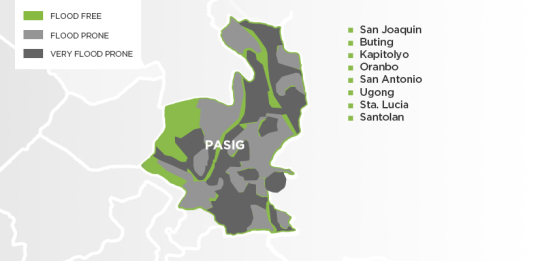
Pasig is another highly-urbanized city in the metro and a hotbed of financial, commercial, industrial and residential properties, thanks to its close proximity to Ortigas Center. A series of mid-rise residential developments can also be seen along Amang Rodriguez Avenue, a clear indication that the city is resilient to the effects of bad weather. Urban living development projects are also seen blending in among commercial properties along Mercedes Avenue. Pasig is also the location of Frontera Verde by Ortigas & Company, a private development that houses a local version of the Chatuchak Market in Bangkok, Tiendesitas.
Because of the susceptibility of the majority of Pasig, the city government has since responded by implementing a public service program designed to mitigate the effects of flooding due to river overflow, including the building of its own pumping stations and dikes as said in a report by Rappler.
Parañaque City
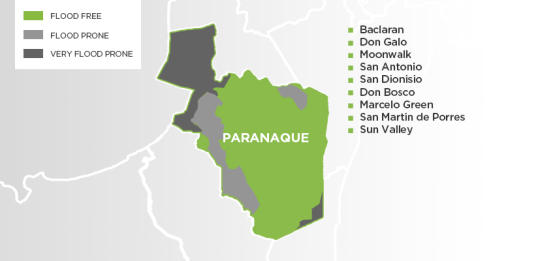
Parañaque City is regarded as a major business and trade center in the metro due to its close location to the sea. The southern parts of the city have been favored by developers to build residential properties for middle-class to upper middle-class homeowners. On the other hand, its location has proven to be a big problem when the country started being plagued with aggressive weather disturbances in the recent decade. On the other hand, a flood control program has been set in place by Paranaque City Mayor Edwin L. Olivarez ever since his ascension to office in 2009. The program, which was first tested last year, was regarded as a success because the city’s flood-prone areas did not experience heavy floods unlike the other neighboring cities during Typhoon Gorio.
Pasay
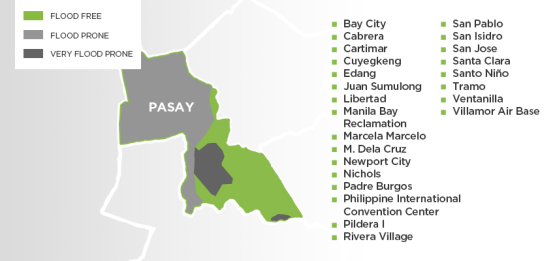
When one would think of Pasay, there are at least three large-scale properties in mind: SM Mall of Asia, Resorts World Manila and the Ninoy Aquino International Airport 3. These three developments, along with several other commercial and residential properties that take advantage of the view the coastline of Pasay extending to Manila Bay offers, indicate how the city retains its title as the face of Manila. The Roxas Boulevard area is home to a plethora of entertainment establishments, luxury hotels, and even national government offices.
Although Manila Bay will continue to present itself as a threat to this promising city, the business districts and development areas remain virtually untouched by flood waters.
Want to live in a flood-free city in Metro Manila? Explore properties for sale here.
Like What you've read?
-
MariusDejess
-
Zip Antonio
-
-
mikael











